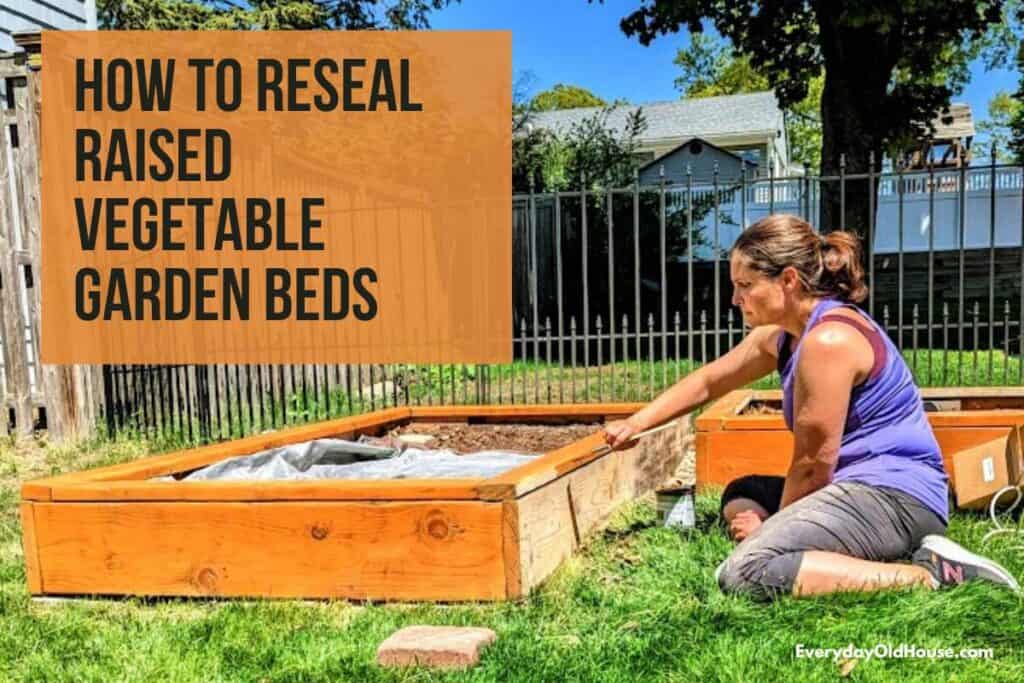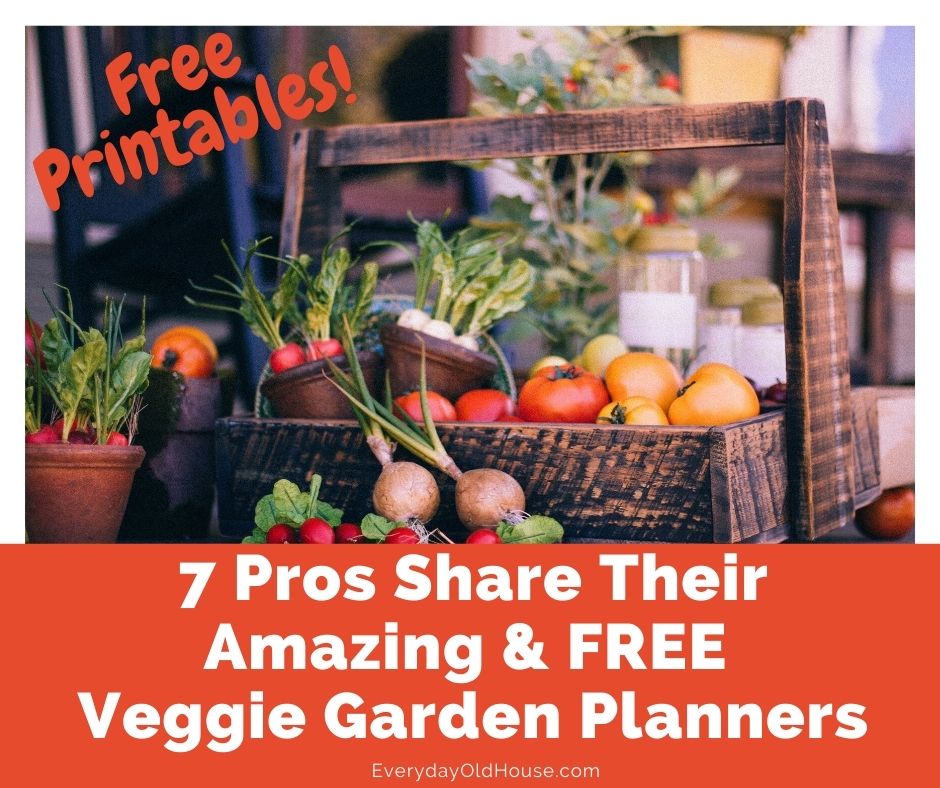I’ve tried my hand at vegetable gardening for almost two decades. In the beginning, it was just a few plants – perhaps a few tomato and pepper plants. Other years, the garden has grown, and now includes green beans, lettuce, cucumbers, watermelons, and various herbs. I’ve had successes. I’ve definitely experienced some failures.
But regardless of how much (or how little) my garden yielded, I always enjoyed the act of digging in the dirt and nurturing my little suburban vegetable garden. It wasn’t until the pandemic (with its supply chain issues and gobal unrest) that I formally considered ALL the benefits of victory gardens.
May these 10 benefits of victory gardens inspire you to pick up a trowel and create your own veggie and herb garden to feed and nourish your body and soul.

This post contains affiliate links, including but not limited to, Amazon Associates. As such, I earn from qualifying purchases. Full disclosure located here.
History of Victory Gardens
As Julie Andrews sings in The Sound of Music, “let’s start at the very beginning, a very good place to start….”
The concept of a victory garden is not new. It started during World War I, and resurged in World War II, when a severe food crisis emerged as agricultural workers were recruited as soldiers and trains and trucks were used to transport those soldiers, as well as vehicles and weapons.

To alleviate the food shortages and ensure enough food for soldiers fighting overseas, the government encouraged citizens to contribute to the war effort by planting their own gardens, termed “Victory Gardens.” They wanted individuals to grow their own fruits and vegetables as a way for communities to provide for themselves and do their part on the home front.
And the government’s urging for Americans to join an “army of gardeners” and “sow the seeds of victory” worked! Everyday Americans picked up their shovels and raised to the challenge by pitching in and planting their own victory gardens in every nook and corner available. Suzan at It’s My Sustainable Life has a great WWII-era Victory Garden video (as well as tips on what to grow in your victory garden) worth checking out.
At their peak, there were over 20 million victory gardens in the US during WWII, producing over 40% of all vegetables grown in the US. These gardens yielded over 1 million tones of vegetables, equivalent to the weight of 120,000 elephants or 17,000 army tanks! WOW!
10 Benefits of Victory Gardens
Now I’m not saying that the pandemic is anything near the tragedies seen during these two World Wars. But these eras do share some similar conditions – shortage of fresh produce in grocery stores, low morale, feeling of helplessness, and financial stress.
Having a victory garden during the pandemic was a great solution to alleviate some of the issues. BUT there are several more (I found 10, to be exact ?) benefits of victory gardens that have nothing to do with global issues.
While some are these benefits of victory gardens are obvious, many I wouldn’t have thought of on my own. Hopefully one (or more) of these reasons will inspire you to pick up a hoe, plant from seeds, and harvest a delicious bounty to produce for your kitchen table.
Cause we all need a victory, right?
1. Save Money
Planting a victory garden is the perfect way to access fresh, healthy foods at a relatively low cost. With this pandemic triggering high levels of unemployment and a general unease with job stability, planting a victory garden can help you stretch your budget.
Oregon State University estimated that on average, the cost of materials and supplies for home vegetable gardens is $238, which yields a $677 worth of fruits and vegetables. That is over $400 in potential savings!
And if you know me, you know I’m thrifty. And if I can potentially save $400 on my grocery bill? You know that I consider that one dang good reason to plant a victory garden.
Heck, you might get into it so much that you’ll get into it full-time and ultimately, learn how to make money homesteading!!!
2. Better Taste
If you have ever tasted a homemade tomato straight from the garden, you know what exactly what I’m talking about. Homegrown, fresh-picked vegetables, herbs and fruit provide an amazing taste experience.
You just can’t get this same depth of flavor and intensity from store-bought. It might be one of the reasons I eat more fruits and veggies from my garden in the summer – they just taste better.
If curious, garden blogger Journey with Jill dives into the reasons why homegrown produce taste better. Jill also has a Beginner’s Garden Podcast with easy-to-understand tips and resources for beginners to get the most out of their gardens. I haven’t had a chance to listen yet (I just found her blog this week) but when I have the spare moment while the kids are running around…..

3. Fresh Air and Stress Relief
It’s amazing what can happen to your mental health when you get outside and get some fresh air. Gardening is the perfect way to get outside, cure boredom, and alleviate stress.
Don’t be surprised if you find one of the benefits of victory gardens extremely calming and mood-lifting. Research has shown that people have measurable lower cortisol levels (aka the “stress hormone”) after gardening for just 30 minutes.
And with all the chaos currently happening in this world, many of us feel that we have lost control of our lives. How can we not feel a little more stress these days? Planting a victory garden can help manage and alleviate that stress, bring peace, give control over when we all feel helpless, and help our overall well-being. How can this not be one of the top benefits of victory gardens?
4. Eat Healthier
Besides the mental health benefits of gardening, a victory garden promotes a better diet by supplying fresh, healthy produce. In other words, you will eat more veggies. Your mother will be proud!
And it looks like most Americans need to eat healthier. According to a study published in the Center for Disease Control (CDC) only about 1 in 10 adults meets federal recommendations for fruits and vegetables. These recommendations include eating 1 ½ to 2 cups of fruits and 2-3 cups of vegetables daily.
Honestly, I struggle to eat 2 cups of veggies everyday. And may be you do too. But, if we spend time, energy and money in tending a garden all summer, we will eat everything we harvest. And that will lead to a healthier diet. (If you are interested in veggie that pack a protein punch, check out Top 21 High Protein Veggies).
And we aren’t the only ones who will benefit from digging in the garden. If you have been struggling with encouraging your children eat their fruits and vegetables, search no further than your backyard. Studies have proven that children eat more fruits and vegetables if they are homegrown. One study found children’s consumption of fruits and vegetables more than doubled when parents grew a vegetable garden in their yard
And research shows this habit may continue throughout adulthood, with these young gardeners growing up into adults who eat more their fruits and veggies.

5. Improved Health
While I researched the reasons to grow a victory garden I was surprised by the wide range of health conditions that gardening can positively affect. Did you know that a victory garden can improve your health literally from head to toe?
Research proves that gardening will help numerous health conditions, such as:
- Lower blood pressure
- Cut stroke and heart attack risk
- Lower risk of dementia and Alzheimers
- Strengthen bones and joints
- Lower your risk for diabetes
6. Learn a New Skill and Hobby
Hobbies provide a fulfilling and productive use of our free time. It enriches our lives and honestly, makes us more interesting people.
Planting and tending to a victory garden is a fun and educational way to make the most out of our mandated quarantines with several benefits. How?
This is the opportunity to learn new skills – like how to propagate a lemon tree – and grow (pun intended) individually as well as together as a family.
7. More Family Time
Speaking of family time, there are several aspects of growing a garden that helps nourish your family’s body and soul.
Gardening together as a family brings SO many benefits. Especially for the little ones. Starting a garden and getting little hands dirty brings a host of benefits, including:
- Replacing tv and computer screen time
- Brings families together to spend time
- Develop a sense of cooperation and commitment by working on a mutual project
- Accessibility to connect with nature
- Increase pride in contributing to meals
Plus there is a huge education factor in benefits of victory gardens for children, including science (botany, weather) and math (measurements). As I discuss further here (5 Home Projects for Families You Can ACTUALLY Accompsih), including children in home improvement projects can be beneficial to both parents AND children.
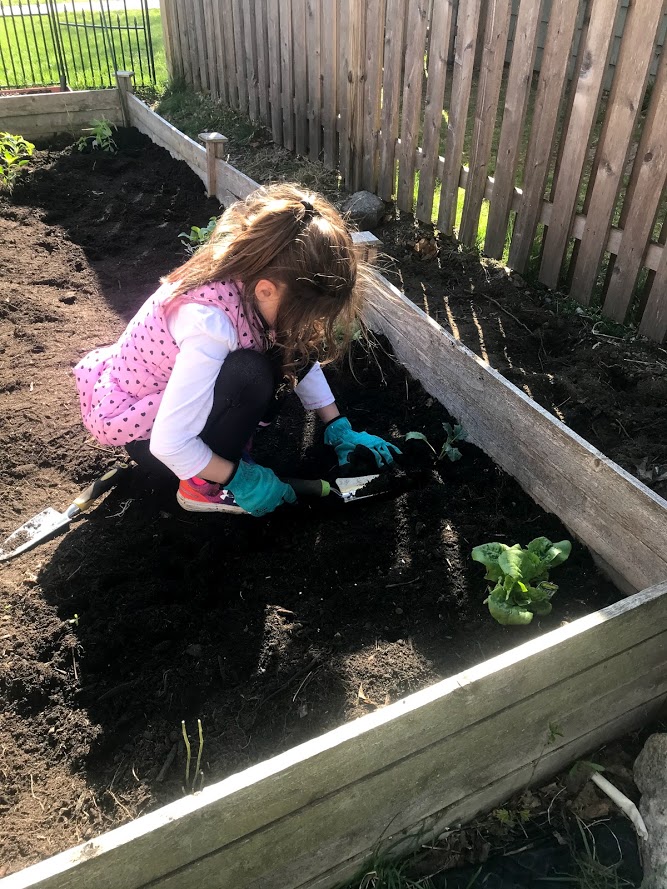
Unsure where to start in gathering up the family and starting a victory garden? Try this method:
- Hold a family meeting to discuss and decide which of your favorite fruits and vegetables to grow and where to find them.
- Learn if they can actually grow in your geographic area. And if so, what these plants need to successfully grow, from soil conditions to how far way they must be planted from each other.
- Roll up your sleeves and plant the garden together.
- Assign different tasks to each family member to help tend the garden.
- Watch the plants progress as these fruits and veggies sprout from seed, grow buds, and produce delicious fruit and vegetables.
- Learn the best time and way to harvest and find new recipes to enjoy product.
- Lastly, learn how to preserve or freeze the excess to ensure all that great food doesn’t go to waste.
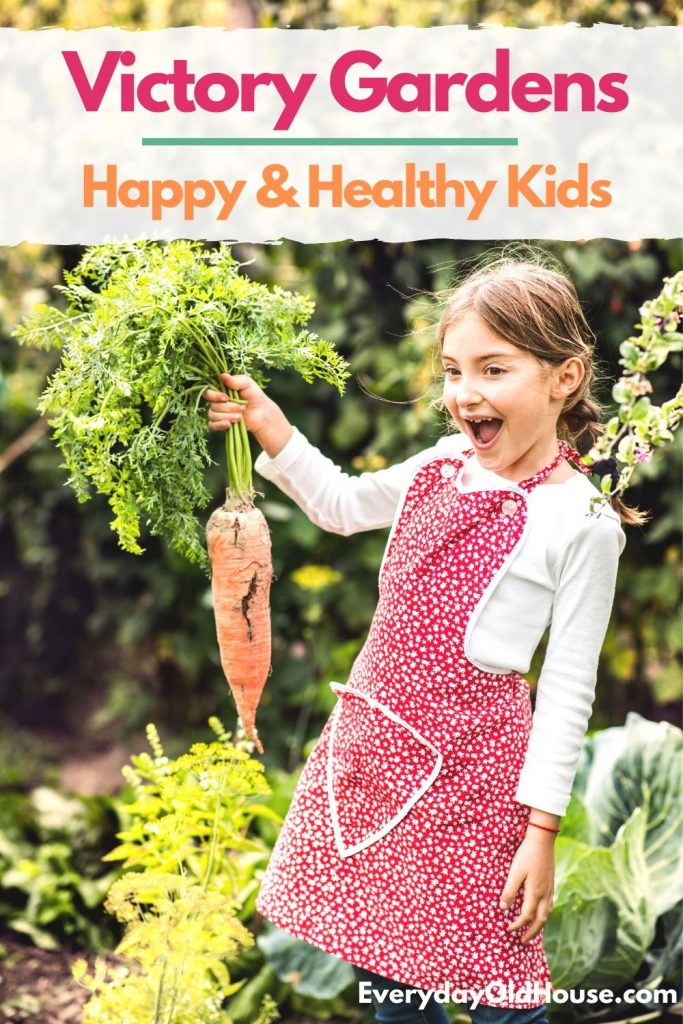
8. Environmentally Friendly
Growing your own food, whether it be in your backyard or a local community garden, not only benefits you, but also the environment.
Carbon Footprint and Waste
First, we reduce carbon emission and waste by cutting down on the fuels needed to transport. Did you know that the produce we buy in stores travels an average 1500 miles to get to the store? Yikes – that’s quite a trip!
Shipping and transport burns fossil fuels, which produces greenhouse gases that increase global warming. Planting our own victory gardens reduces these effects.
Plus by growing our own food, we are reducing waste from food packaging materials such as man-made plastics and cardboard, that also travel hundreds and thousands of miles.
Avoid Pesticides
One of the many benefits of victory gardens is the peace of mind knowing what you and your family is exactly eating. Farms use pesticides and synthetic fertilizers to grow crops at high yields. And some of these have even been proven to cause cancer and other diseases.
Planting a victory garden and using safe and natural fertilizers reduce the amount of harmful chemicals in the environment, as well as in your body.
9. Exercise More
Raise your hand if you are a natural couch potato (I’m raising my hand…). Rolling up our sleeves and digging in a garden is a much-needed reprieve from our society’s sedentary, indoor lifestyle.
If you have spent a spring weekend working in your yard, you can attest that gardening can be, uh, well an unexpectedly strenuous workout…
- Lifting and moving bags of soil and mulch.
- Stretching and reaching to prune tall branches.
- Pulling (and fighting with) weeds and overgrown roots.
- Shoveling soil to transplant or dig new holes.
- Bending to plant or extending to rake.
Whew! I don’t know about you, but the day after working in my garden my body aches! I’m completely sore from head to toe. And I’m not THAT old….
Gardening with all that movement improves strength and flexibility. And bonus points, gardening also burns calories.
According to Centers for Disease Control and Prevention (CDC), one hour of light gardening and yard work constitutes moderate-intensity exercise. You can burn about 330 calories an hour just from gardening.
And this could lead to losing weight (yippee! Admittedly, I could afford to lose a few pounds…..) Studies have shown that people who participated in a community garden program had significantly lower BMIs (body mass indexes) than their non-gardening neighbors.
10. Food Security
While food security has greatly improved since the pandemic in 2020, in my geographic area we still aren’t completely back to normal. (On a side note, it makes me realize just how blessed we have been all these years with consistent and reliable food in our stores).
Growing a victory garden with your favorite vegetables and fruits may insulate you from food insecurity impacts and provide a reliable supply of produce. By growing your own favorite fruits and vegetables, you can count on having them on the kitchen table for your family.
Plus, if your garden provides a high yield of fruits and veggie, you can either freeze or preserve the extras to eat in during the cold months.
My Victory Garden
As of this post, it’s late April here in New England and I just wanted to share my little victory garden. So far I have lettuce, radishes, garlic, and onions planted, with some tomato and pepper seedlings in the back (I know those are too early to plant, but I just couldn’t resist buying at the store).
In the photo below, the stakes (currently lying down) will soon have carrots, green beans, cucumber and maybe something else that tickles my fancy.
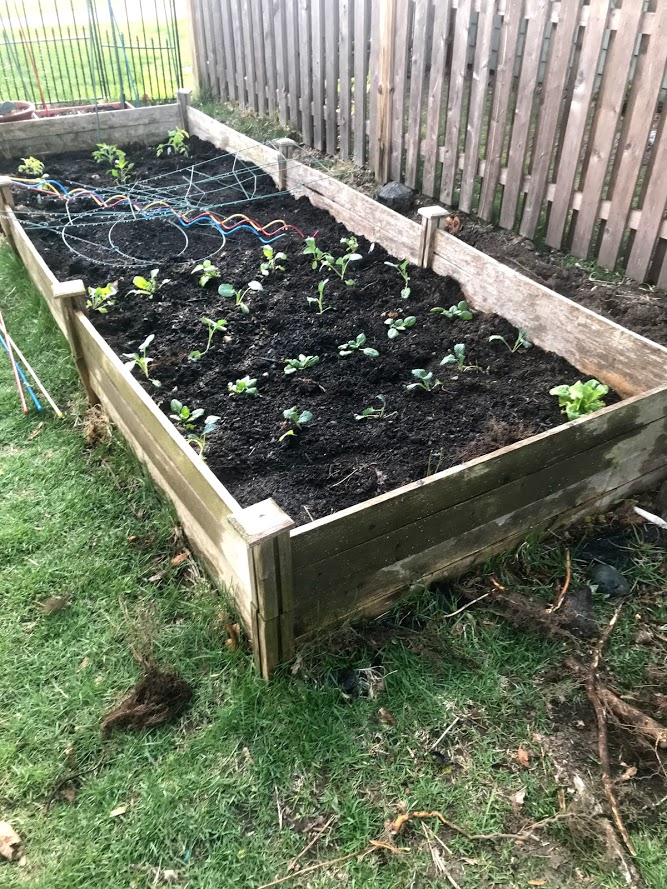
Elsewhere in my yard I have raspberry and blueberry bushes, and a strawberry patch. Recently I learned how to design and build a blueberry bush cover with netting and PVC pipes to stop the birds and little critters from grabbing our berries.
Related Posts
Want to be the first to know about new posts? Be sure to follow me on Pinterest, Facebook, Instagram or Twitter of even Etsy! Or better yet… Subscribe below!
My monthly (admittedly sometimes more, sometimes less….) emails are like receiving a unexpected letter from an old friend WITHOUT needing to put on your slippers and walk out to your mailbox…. See? I got ya, my friend!)
[Note: My posts are proudly connected to these amazing link parties full of DIY ideas and inspiration!]

